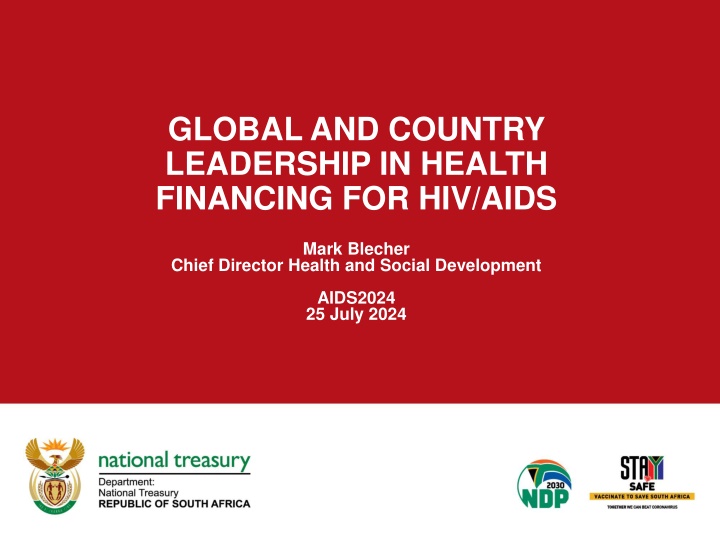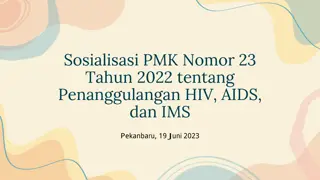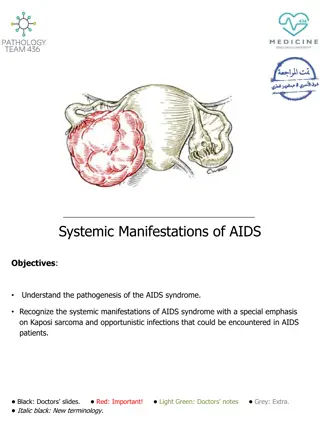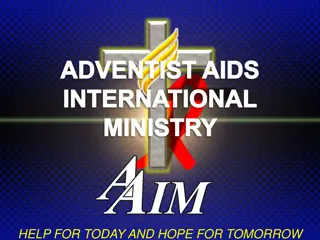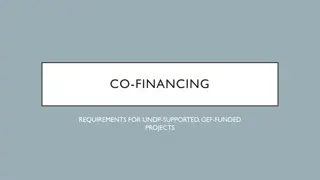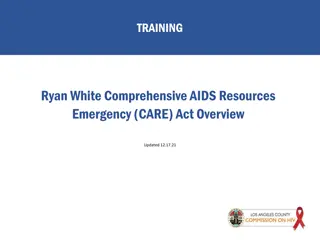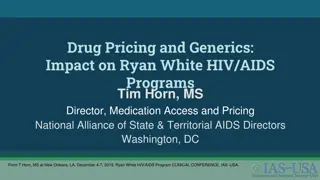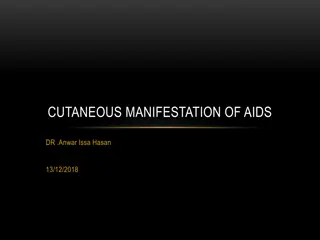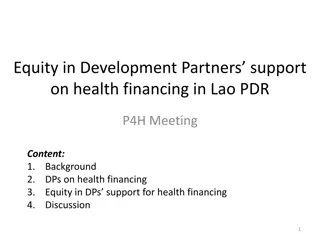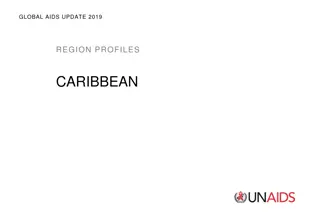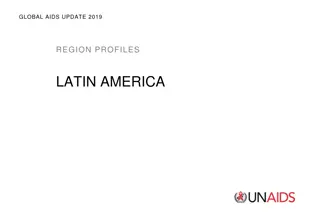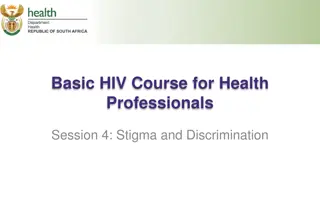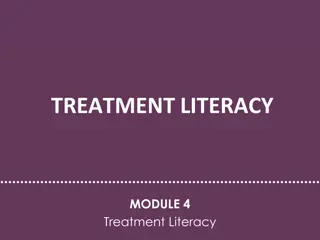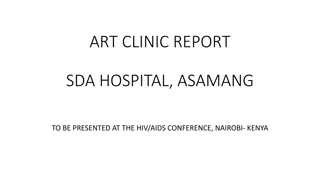Global and Country Leadership in Health Financing for HIV/AIDS
Sustainable financing for HIV/AIDS requires a broader perspective on health financing, primary care financing, and addressing major health financing shortfalls. Leaders must focus on practical strides in improving health expenditure in countries with insufficient funding, low prioritization of health, and high donor dependency. Governments and global organizations need to show leadership in developing domestic tax systems to support health financing objectives.
Download Presentation

Please find below an Image/Link to download the presentation.
The content on the website is provided AS IS for your information and personal use only. It may not be sold, licensed, or shared on other websites without obtaining consent from the author.If you encounter any issues during the download, it is possible that the publisher has removed the file from their server.
You are allowed to download the files provided on this website for personal or commercial use, subject to the condition that they are used lawfully. All files are the property of their respective owners.
The content on the website is provided AS IS for your information and personal use only. It may not be sold, licensed, or shared on other websites without obtaining consent from the author.
E N D
Presentation Transcript
GLOBAL AND COUNTRY LEADERSHIP IN HEALTH FINANCING FOR HIV/AIDS Mark Blecher Chief Director Health and Social Development AIDS2024 25 July 2024
INTRODUCTION AIDS, unlike COVID-19, is a long term issue and so sustainable financing almost certainly needs to be looked at also through a lens of broader health financing and primary care financing Numerous competing/complementary priorities e.g. NCDs and progressive integration on ground in many countries also requires broader perspective At same time laser-like approach to pandemic control is important Need to make measurable strides in addressing major health financing shortfalls in 30-40 countries Prevention and key populations currently especially neglected by domestic government financing in several countries The relevant countries and regions supported by global government (WHO, G20, GF, WB, IMF etc.) need to make measurable progress on measurable health financing objectives for these 30-40 countries 2
40 countries government spending <$30 pa on health Below basic package Unable to employ sufficient health workers Leads to high reliance on out-of-pocket catastrophic health expend and Often weaknesses in tax system and prioritisation of health driven by Call on 40 countries, global and regional organisations to show leadership making practical strides in addressing this problem in 3
42 countries spending <7% of government budget on health Low prioritization of health High debt payments can contribute Political problem of low prioritization Leads to high out of pocket expenditure Sometimes substitution donor Requires attention and leadership by domestic and global and regional players to address sustained 4
Tax to GDP ratios Africa 2021 Source ATAF -Some countries have inadequately developed tax and revenue systems -Country leadership to develop domestic tax and revenue systems -Varies by yr and revenue can be broader than tax -Support by global and regional government and expert groups eg ATAF, IMF. WB
Domestic government health expenditure (GGHE-D) per capita (2021 constant US $) Current health expenditu re (CHE) as % of GDP Government health expenditure as % of total government expenditure Share of external HIV expenditure as % of total HIV expenditure Total HIV expenditure as % of total health expenditure Country High donor dependency in several countries Angola Botswana Brazil Cameroon Central African Republic Congo C te d'Ivoire DRC Equatorial Guinea Eswatini Ethiopia Gabon Gambia Ghana Guinea-Bissau India Indonesia Kenya Lesotho Malawi Mexico Mozambique Myanmar Namibia Papua New Guinea Rwanda South Africa South Sudan Suriname Thailand Uganda Tanzania, United Rep. of 3.4% Viet Nam Zambia Zimbabwe 2.9% 6.2% 9.9% 3.7% 8.6% 3.6% 3.3% 3.8% 3.5% 6.9% 3.3% 3.0% 3.4% 4.2% 8.1% 3.2% 3.3% 4.5% 10.8% 7.2% 5.9% 8.2% 5.0% 8.9% 2.3% 7.0% 8.4% 8.1% 7.1% 4.4% 4.3% $32 $302 $336 $8 $5 $33 $27 $3 $51 $138 $7 $130 $13 $50 $7 $23 $76 $43 $52 $9 $287 $11 $11 $203 $35 $23 $326 $4 $301 $226 $8 $12 $69 $32 $13 7.2% 12.8% 9.9% 2.9% 5.4% 7.2% 5.8% 5.0% 4.9% 11.3% 6.2% 9.6% 7.6% 8.4% 3.9% 3.7% 10.3% 8.8% 9.4% 7.1% 11.0% 7.2% 3.6% 10.8% 6.2% 9.1% 15.3% 2.1% 13.5% 12.6% 4.1% 6.5% 9.2% 9.1% 4.8% 3.8% 13.7% 0.4% NA 11.6% NA 1.0% 9.6% NA 28.6% 1.9% 1.1% NA 3.9% NA 0.2% 0.4% 15.2% 41.9% 26.0% 1.2% 36.8% 3.0% 12.7% 3.4% 23.1% 7.1% 7.1% NA 1.1% 27.1% 23.6% 21.4% 37.7% 0.0% NA 84.7% NA NA 73.2% NA 59.0% 95.5% 4.7% NA 40.9% NA 0.0% 45.0% 43.9% 76.5% 96.7% 0.6% 96.5% 81.6% 32.8% 77.3% 91.0% 27.1% 73.5% NA 8.5% 83.6% 98.9% In some countries HIV is still a significant share of total health expenditure Several countries still heavily dependent on donor financing Dependency esp. for prevention and key populations Sources: AIDS Info, WHO, GF, UNAIDS 4.6% 6.6% 3.0% NA NA 0.3% 40.0% 98.3% 6 75.0%
NEED FOR RESTRUCTURING DONOR INCENTIVES AND REDUCING FRAGMENTATION Serious problem with donor substitution Malawi has to manage and try to coordinate over 250 fragmented donor organisations Future of global health initiatives (e.g. Lusaka agenda) on donor defragmentation Need to change structure of donor incentives to incentivise country own funding Need global, regional, country and donor leadership to solve the <$30 government funding for health problem 7
Critical shortfall in funding for HIV response for low- and middle-income countries (UNAIDS) Source: UNAIDS financial estimates and projections, 2024 -A widening funding gap is holding back the HIV response in low- and middle-income countries. Approximately US$ 19.8 billion (2019 US dollars) was available in 2023 for HIV programmes in low- and middle-income countries - almost US$ 9.5 short of the amount needed in 2025 -Development assistance for HIV has been and will continue to be crucial, with the United States President s Emergency Plan for AIDS Relief (PEFPAR) and the Global Fund playing essential roles. They are also the largest funders of grants for health systems generally. Note: The resource estimates are presented in constant 2019 US$ billions.
International financing is in flux The US$ 8.0 billion in external funding that was available for HIV in 2023 was 3% lower13 than in 2022. There have been major shifts in the main sources of this funding over the past decade, with financing support from bilateral donors dwindling dramatically, a trend that began in 2014. The overall reductions in external HIV resources would be much steeper were it not for sustained and high levels of funding from the Global Fund and the United States Government, which have increased by about 39% and 31% in real terms, respectively, in the past decade. Source: UNAIDS financial estimates and projections, 2024 Note: The resource estimates are presented in constant 2019 US$ billions. Global AIDS Update Report 9
Urgent need to scale up programmes for HIV prevention and societal enablers Unlike for HIV treatment, there continues to be a very large unmet need for resources for HIV prevention and societal enabler programmes in almost all regions. An estimated US$ 1.8 2.4 billion was available for primary prevention programmes in low- and middle-income countries in 2023, compared with the estimated US$ 9.5 billion that will be needed in 2025. Total spending on societal enabler programmes in 2023 was estimated at US$ 0.9 1.1 billion, almost US$ 2.0 billion short of the estimated US$ 3.0 billion needed in 2025 Source: UNAIDS financial estimates 2024 Global AIDS Update Report 10
NEED FOR COUNTRY AND GLOBAL LEADERSHIP Call on 43 countries, global and regional organisations Step up leadership on health financing Make progress to ensure no country is allocating < $30-40 pcpa of government funds GGHE-D to health (reduce from existing 40 countries) (Target supposed to be closer to $70-80 minimum for LICs) Make progress to ensure all countries allocating at least above 7-8% for health (i.e reduce from existing 42 countries) (Abuja target is 15%) Some countries need to make progress on domestic taxation systems so can do what need to do Countries need to increase their share of funding (still currently heavy donor reliance in too many countries) Increase country contributions to prevention and key populations (very low in many countries) 11
ACKNOWLEDGEMENTS WHO (GHED 2023) UNAIDS: Jaime Atienza Azcona, Deepak Mattur, Charles Birungi Global Fund: Shufang Zhang Brandeis Uni: Prof Nandakumar 12
